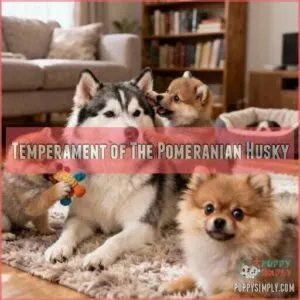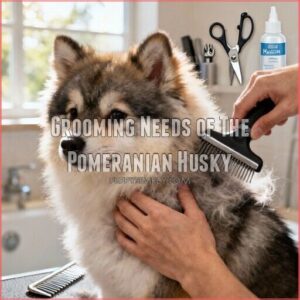This site is supported by our readers. We may earn a commission, at no cost to you, if you purchase through links.

They’re the result of artificial insemination (nature draws the line somewhere), and they’ve exploded in popularity over the past decade. With their piercing blue eyes, fox-like faces, and coats that shed enough fur to knit a sweater, Pomskies aren’t your typical lap dog.
They’re intelligent, stubborn, and fiercely loyal companions who demand more than just good looks to thrive in your home.
Table Of Contents
- Key Takeaways
- Overview of The Pomeranian Husky
- Appearance of The Pomeranian Husky
- Temperament of The Pomeranian Husky
- Exercise Needs of The Pomeranian Husky
- Grooming Needs of The Pomeranian Husky
- Health Concerns of The Pomeranian Husky
- Finding a Pomeranian Husky Breeder
- Cost of a Pomeranian Husky
- Training a Pomeranian Husky
- Is a Pomeranian Husky Right for You?
- Frequently Asked Questions (FAQs)
- How much do Pomeranian Huskies cost?
- How big will a Pomsky get?
- Do Pomsky shed a lot?
- What is a pomeranian husky called?
- Are Pomeranian Huskies good with children?
- How big do Pomeranian Husky puppies get?
- What colors can Pomeranian Huskies be?
- Can Pomeranian Huskies live in hot weather climates?
- How long do Pomeranian Huskies live?
- What do Pomskies eat and how much?
- Conclusion
Key Takeaways
- Pomskies are created through artificial insemination between Pomeranians and Siberian Huskies, resulting in a designer dog that weighs 15-30 pounds with striking features like piercing blue eyes and thick double coats that shed heavily twice a year.
- These intelligent but stubborn dogs demand a serious training commitment and 30-60 minutes of daily exercise, making them better suited for active, patient owners rather than first-timers seeking low-maintenance lap dogs.
- Expect to invest $20,000-$32,000 over their 12-15 year lifespan, with upfront costs ranging from $1,500-$6,000 plus ongoing expenses for grooming, veterinary care (including genetic conditions like hip dysplasia and eye problems), and quality food.
- They’re fiercely loyal family companions with strong protective instincts and vocal tendencies that require early socialization to prevent standoffish behavior, making them excellent watchdogs but potentially challenging for apartment living or homes with young children.
Overview of The Pomeranian Husky
The Pomeranian Husky—better known as the Pomsky—is what happens when you cross the fluffy sass of a Pomeranian with the striking beauty of a Siberian Husky, creating a designer dog that’s stolen hearts since breeders first made it happen in the early 2010s.
This Pomeranian Husky Mix brings together the best of both breed histories—the Husky’s wolf-like elegance and the Pomeranian’s compact charm. As hybrid benefits go, you’re looking at intelligent dogs that pack big personality into a medium-sized frame, usually weighing 15 to 30 pounds and standing 10 to 15 inches tall.
These loyal companions thrive as family pets in active households, though they’re not officially recognized by the American Kennel Club due to their mixed heritage. What they lack in pedigree papers, they make up for in spirited energy and undeniable cuteness that’s hard to resist.
Appearance of The Pomeranian Husky
If you’re wondering what this feisty little designer dog actually looks like, picture a Husky that somehow got shrunk down to lap-dog size—and you’re pretty close to the mark. The Pomeranian Husky Mix sports those striking Facial features you’d recognize from a Siberian Husky—pointed ears, a fox-like snout, and an alert expression—all wrapped in a compact package.
Physical Characteristics vary wildly depending on which parent they take after. Males usually stand 12-15 inches tall and weigh 20-30 pounds, while females measure 10-13 inches and tip the scales at 15-25 pounds. Their Coat is thick and double-layered, coming in impressive Coat variations like gray and white, black and white, brown, or even brindle. Unique markings add individual flair.
The real showstopper? Those mesmerizing eyes. Eye color ranges from brown to blue, hazel to amber—sometimes you’ll even see heterochromia, where each eye sports a different color entirely.
Temperament of The Pomeranian Husky
Behind those stunning eyes lies a personality that’s just as enchanting—and maybe a touch more complicated than you’d expect from such a cute face. Pomsky temperament and personality blends playful energy with fierce Loyalty Levels. These dogs form deep bonds with their families, showing constant Affection Display through cuddles and follow-you-everywhere devotion.
Here’s the catch: Protective Instincts run strong, making them naturally wary of strangers. Socialization Importance can’t be overstated—early exposure to different people, pets, and situations prevents standoffish behavior from turning into actual problems. Vocal Tendencies also come with the territory. Your Pomeranian Husky Mix Temperament includes alert barking whenever someone approaches, which makes them excellent watchdogs but potentially challenging apartment companions.
Intelligence? Off the charts. Stubbornness? Also present. This Temperament and Behavior combo means you’re getting a smart, independent thinker who’ll test boundaries while stealing your heart.
Exercise Needs of The Pomeranian Husky
That lovable bundle of fluff packs more energy than you might guess, and skipping daily exercise isn’t an option if you want a well-behaved companion. Your Pomeranian Husky Mix Exercise Needs demand at least 30 minutes of Daily Walks, but most thrive with closer to an hour. These Exercise Routines keep your Pomeranian Husky Mix physically fit and mentally balanced.
Physical Fitness directly impacts behavior—tired Pomskies are good Pomskies. Combine Training and Exercise for maximum benefit, teaching commands during walks or incorporating agility obstacles into playtime. Without proper Exercise Needs being met, expect destructive chewing and non-stop barking.
Here’s what keeps them happy:
- Play Activities like fetch, tug-of-war, or chase sessions burn excess energy while strengthening your bond
- Mental Stimulation through puzzle toys and hide-and-seek games prevents boredom-driven mischief
- Off-leash running in secure areas lets them stretch those Husky genes
Grooming Needs of The Pomeranian Husky
Your Pomsky’s gorgeous double coat comes with a price tag—expect to brush that thick fur at least three times a week, and daily during shedding season. Pomeranian Husky Mix Grooming isn’t for the faint of heart, but proper Brushing Techniques using a slicker brush and metal comb prevent painful mats from forming. Shedding Control requires extra effort twice yearly when they "blow" their undercoat.
Pomeranian Husky Mix Coat Care also means monthly baths to keep that silky fur looking sharp. Don’t overlook Nail Care—trim those nails every 3-4 weeks to avoid painful splits. Ear Cleaning deserves weekly attention since their fluffy ears trap moisture and debris.
Regular Dog Grooming routines keep your Pomsky comfortable and healthy. Skip Coat Maintenance, and you’ll find tumbleweeds of fur decorating every corner of your home.
Health Concerns of The Pomeranian Husky
Mixing two breeds sounds like genetic roulette, and with Pomskies, that’s partly true. Genetic Disorders lurk in both parent lines—up to 15% of breeding lines carry genes for canine multifocal retinopathy, an Eye Problems condition that can cause blindness. Hip Dysplasia, inherited from either side, may require surgery costing $3,000 per knee. Pomeranian Husky Mix Health Issues include collapsing trachea (that distinctive goose-honk cough), dental disease requiring treatments exceeding $1,700, and Common Allergies showing up as itchy skin and ear infections.
Health Testing before breeding matters—responsible breeders screen for joint and eye conditions through OFA and CERF. Veterinary Costs add up fast: 1 in 10 owners spend over $2,800 treating gastrointestinal issues alone.
This Pomeranian Husky Mix Health Guide emphasizes Preventative Care—annual checkups, monthly heartworm prevention, and dental hygiene dramatically reduce long-term Health Issues and expenses. Understanding Pomsky care needs is essential for potential owners to make informed decisions.
Finding a Pomeranian Husky Breeder
Finding a trustworthy breeder separates heartbreak from happily-ever-after when you’re hunting for a Pomsky. With over 50 active breeders scattered across 27 states, your options seem endless—but quality varies wildly. Over 70% affiliate with the American Pomsky Kennel Club or Pomsky Owners Association, organizations that enforce Breeder Ethics and Breeding standards. These groups demand Health Guarantees and proper Registration Process documentation, protecting you from puppy mill disasters.
Smart screening works both ways:
- Check if they conduct DNA testing and OFA screenings for hips, eyes, and cardiac health (only 16% do the full panel)
- Request documentation showing Breeder Accreditation through APKC or POA
- Tour facilities in person—ethical breeders welcome visits and answer questions about their Pomeranian Husky Mix Breed Information
- Confirm their health guarantee covers genetic conditions for at least one year
Expect wait lists averaging four to eight months. Reputable Dog Breeding operations prioritize health over Puppy Costs, and their Pomeranian Husky Mix Care Guide should prove it. When searching for a Pomsky, consider visiting Pomsky puppies to find a healthy and well-socialized companion.
Cost of a Pomeranian Husky
Buying a Pomsky isn’t pocket change—you’re looking at $1,500 to $6,000 upfront, depending on breeder reputation and those trendy blue eyes or fluffy white coats. But the sticker price is just the opening act. First-year costs balloon to $5,380–$13,055 when you factor in vet visits, vaccines, supplies, and that adorable crate. After year one, expect $1,200–$2,200 annually for food, grooming, preventive meds, and the occasional emergency fund raid. Over your Pomsky’s 12-15 year lifespan, you’re committing roughly $20,000–$32,000. Pet insurance averages $400 yearly and softens the blow when knee surgery hits $3,000. Smart budgeting now means fewer financial surprises later.
| Expense Category | First Year | Annual (After Year 1) |
|---|---|---|
| Initial Costs | $1,500–$6,000 | — |
| Veterinary Fees | $700–$1,200 | $300–$800 |
| Monthly Expenses | $960–$1,800 | $960–$1,800 |
Training a Pomeranian Husky
Forget everything you’ve heard about designer dogs being easy—Pomskies pack a Husky’s willful independence into a Pomeranian-sized package that demands serious training commitment. Start obedience training the day your puppy arrives home. Positive reinforcement works magic with this intelligent breed—think treats, praise, and patience instead of harsh corrections. Your Pomsky will learn basic commands quickly, but that stubborn streak means you’ll need consistency to make lessons stick.
Pomskies combine Husky independence with Pomeranian-sized stubbornness, demanding consistent training from day one to channel their sharp intelligence into good behavior
Housebreaking tips? Crate training and frequent outdoor trips prevent accidents. Socialization methods matter just as much—expose your pup to different people, dogs, and environments early to curb their natural wariness of strangers. Behavior correction should always stay calm and firm. Without proper dog training, you’ll end up with a yappy, destructive handful. Invest the time now, and you’ll tap into their impressive trainability.
Is a Pomeranian Husky Right for You?
This breed isn’t for everyone—89% of owners thrive with Pomskies, but success hinges on lifestyle fit. Family dynamics matter: they bond deeply with older kids but need supervision with toddlers. Apartment living works if you commit to 30–60 minutes of daily exercise.
Ownership costs pile up with grooming, vet care, and quality food. Their trainability shines with consistency, but first-timers often underestimate their stubborn streak.
Run a compatibility test: Can you manage moderate shedding, vocal tendencies, and high energy? The Pomeranian Husky mix rewards active, patient owners—not anyone seeking a low-maintenance lap dog.
Frequently Asked Questions (FAQs)
How much do Pomeranian Huskies cost?
You’ll shell out anywhere from $1,000 to $5,000 for Pomeranian Husky Mix puppies from reputable breeders—no nickel-and-diming here. Adoption fees run lower, usually $200 to $500, but Pomsky availability at shelters is rare.
Breeder costs reflect health testing and puppy expenses.
How big will a Pomsky get?
Most Pomsky adults stand 10-15 inches tall and weigh 15-30 pounds, though Size Variance depends on which parent breed dominates. Males usually reach the upper Height Ranges, while females stay smaller, reflecting unpredictable Growth Patterns in this Pomeranian Husky Mix.
Do Pomsky shed a lot?
You’ll find yourself reaching for the vacuum more often than you’d like—these fluffy companions blow their coat twice yearly during shedding season, with moderate hair loss year-round.
Daily grooming tips and consistent fur care during peak times keep coat maintenance manageable.
What is a pomeranian husky called?
This designer dog goes by "Pomsky"—a clever blend of Pomeranian and Siberian Husky. You’ll also hear folks call it a Pomeranian Husky Mix, though Pomsky rolls off the tongue easier and has become the go-to name for this increasingly popular hybrid.
Are Pomeranian Huskies good with children?
While Pomeranian Huskies can bond with families, they’re not ideal for homes with young kids. Their independent streak and high energy mean toddlers’ unpredictable movements might trigger stress.
With older children who understand household safety and parental guidance during interactions, family compatibility improves—but early child socialization remains essential.
How big do Pomeranian Husky puppies get?
You’ll find most Pomsky puppies hitting 10 to 15 inches tall and tipping the scales between 20 and 30 pounds at full maturity.
Their compact, medium build makes them apartment-friendly, though their boundless energy demands consistent daily exercise to keep them happy and healthy.
What colors can Pomeranian Huskies be?
You’ll find these pups sporting a rainbow of possibilities—gray and white, pure white, warm browns, or classic black and white combos.
Their coat color variations reflect the Pomeranian Husky Mix’s dual heritage, with fur patterns ranging from solid shades to striking multi-color combinations inherited from both parent breeds.
Can Pomeranian Huskies live in hot weather climates?
Yes, they can adapt with proper care. Their thick double coat and thermal regulation challenges mean climate compatibility requires vigilance.
Provide shade, air conditioning, and cool water. Schedule dog exercise during cooler hours and watch for overheating signs.
Summer care demands consistent monitoring to keep your Pomeranian Husky Mix comfortable.
How long do Pomeranian Huskies live?
Most people think smaller dogs automatically live longer—but does that hold true for energetic crossbreeds?
Your Pomeranian Husky Mix usually lives 12 to 15 years with proper care, regular vet visits, and a healthy lifestyle that aids their aging process.
What do Pomskies eat and how much?
Feed your Pomsky high-quality dog food formulated for small to medium breeds with high energy levels.
Meal portions depend on age, weight, and activity—usually ¾ to 2 cups daily, split between two meals to support their Nutrition Needs and prevent bloating.
Conclusion
Funny how the dog world works—breeders spent decades perfecting predictable purebreds, only for us to fall head over heels for a wildcard like the Pomeranian Husky.
These designer dogs don’t follow a script. They’re vocal, energetic, and demand your full attention.
But if you’re ready to embrace the chaos, brush daily, and match their stubborn streak with patience, a Pomsky might just become your most unforgettable companion.














